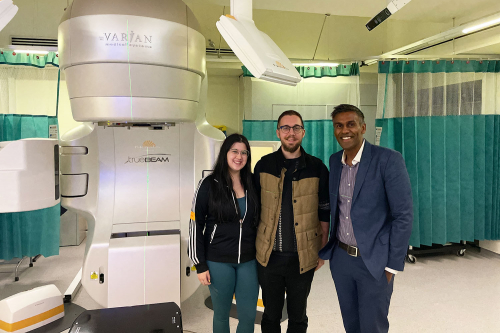About brain tumours
A brain tumour is a collection of abnormal cells growing in or around the brain. Specific causes of brain tumours are unclear, so we need to do more research.
Types of brain tumours
There are many different types of brain tumours. They can be primary or secondary tumours.
Primary brain tumours
Primary brain tumours originate in or next to the brain. Most common adult primary brain tumours are:
- Meningiomas
- Pituitary tumours
- Gliomas, such as astrocytoma and glioblastoma (GBM)
Secondary brain tumours
Secondary brain tumours or metastases are tumours that have spread to the brain. Secondary brain tumours are classified as malignant because they started as cancer elsewhere in the body. For example, metastatic lung cancer began as cancer in the lung which has spread to the brain.
Grades of brain tumours
Brain tumours are graded based on how the tissue looks under a microscope. The World Health Organization (WHO) classification of central nervous system (CNS) tumours is the most widely accepted system to grade primary brain tumours.
These grades help determine the treatment for that tumour type and provide insights into the likely outcome for the patient.
Grade I
- Slow-growing and usually associated with long-term survival
- Unlikely to spread to other parts of the brain
- Well defined and contained edges
- Treated with surgery or radiotherapy; this treatment is usually able to cure the brain cancer
Grade II
- Often referred to as low grade
- Relatively slow-growing cells
- Can invade adjacent normal tissue
- The tumour can progress to become a higher-grade tumour
- Treatment is tailored to individual patients – may include close observation, surgery, radiotherapy, chemotherapy or a combination of these
Grade III
- Often referred to as anaplastic
- Actively reproducing abnormal-looking cells
- Invades adjacent normal brain tissue
- Tumours tend to grow more quickly than Grade II tumours
- Treatment is usually a combination of surgery, radiotherapy, and chemotherapy
Grade IV
- Fast growing
- Poorer prognosis than other grades
- Very abnormal appearance under a microscope
- Treatment is usually a combination of surgery, radiotherapy, and chemotherapy
Symptoms
Patients with brain tumours may present for healthcare with a variety of signs and symptoms.
Symptoms may be associated with the location, size and type of tumour. The most frequent symptoms include:
- Seizure
- Headache
- Nausea and vomiting
- Arm or leg weakness
- Visual problems
- Speech difficulty
- Confusion
Treatment
There is no 'one-size-fits-all' treatment for brain tumours. Treatment decisions are made together with the patient and healthcare team, including neurosurgeons, radiation oncologists, medical oncologists, and other specialists.
Treatment used for brain tumours is based on many factors including overall health, location, size and type of tumour. Your doctors also base treatment decisions on the genetics of your tumour.
Treatment may include surgery, radiotherapy and medical therapy such as chemotherapy, or a combination of these treatments. Tumours of grade II or higher usually require a combination of these therapies.
For higher grade tumours, treatment may be given at the same time or following each other in quick succession. Steroids are also used to control swelling in the brain around the tumour.
Neuroradiology
The two main types of neuroradiology (brain scans) used for people with brain tumours are computed tomography (CT) and magnetic resonance imaging (MRI).
When a person has symptoms that could be caused by a brain tumour, the first scan performed is usually a CT. If an abnormality is seen, an MRI scan will usually be performed as well. Brain scans cannot provide a definitive diagnosis of a brain tumour.
Reasons for doing imaging to manage brain tumours include:
- Provide a radiological diagnosis of a presumed brain tumour
- See where the tumour is within the brain
- See what effects the tumour is having on the surrounding brain
- Treatment planning and management
- Assess whether treatment has been successful - for example, to see if tumour has been left behind after surgery
- Check for complications caused by treatment
- Check for tumour growth or changes after treatment
Neurosurgery
Surgery is usually the first treatment used for a brain tumour. Sometimes surgery is not safe because the tumour is too close to important areas of healthy brain. For Grade I tumours, complete removal may be the only treatment required. For Grade II - IV tumours, surgery alone is rarely sufficient.
Surgery aims to:
- Remove as much of the tumour as possible, whilst minimising damage to surrounding healthy brain
- Provide a sample for examination by the neuropathologist, to confirm diagnosis
- Reduce the amount of tumour to be treated with radiotherapy and chemotherapy
Neuropathology
During the surgery for a brain tumour, a sample of the tumour tissue is taken and sent to the neuropathology lab for a diagnosis.
Once the type of tumour has been identified, the neurosurgeon, radiation oncologist and neuro-oncologist can plan treatment specifically tailored for the patient.
Radiotherapy
Radiation can destroy tumour cells or delay tumour growth. For some Grade I tumours, radiotherapy alone may be sufficient to permanently halt tumour growth. For higher grade tumours, radiotherapy starts within a few weeks of diagnosis.
Chemotherapy
Chemotherapy is the use of drugs to kill cancer cells. The goals of chemotherapy are to destroy the cancer cells left after surgery and slow tumour growth by hindering the cancer cells’ ability to grow and divide. Chemotherapy is typically given after surgery and may be given alone or combined with radiotherapy.


